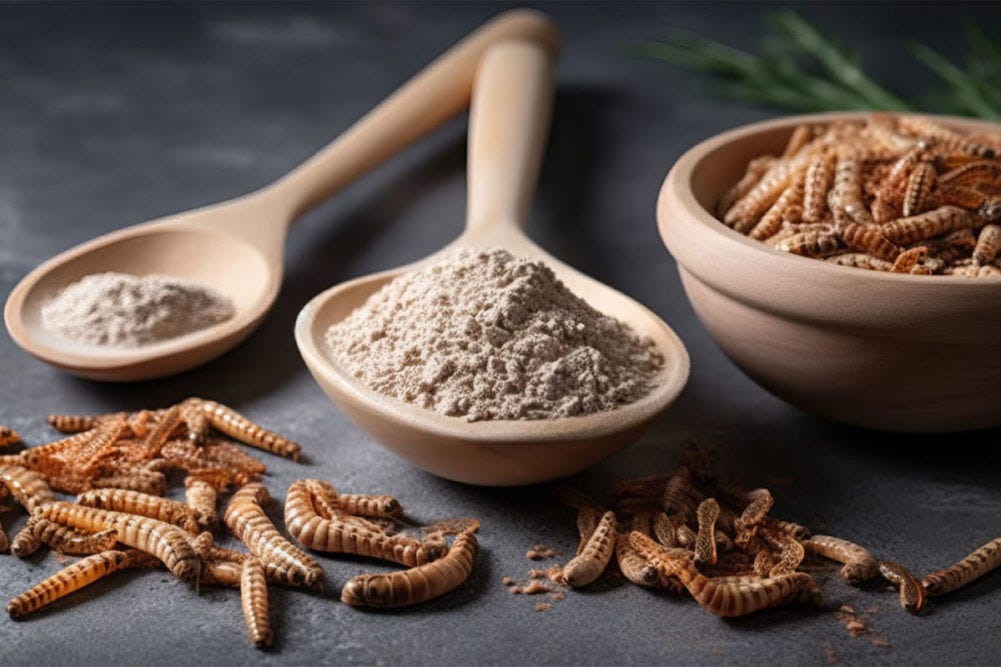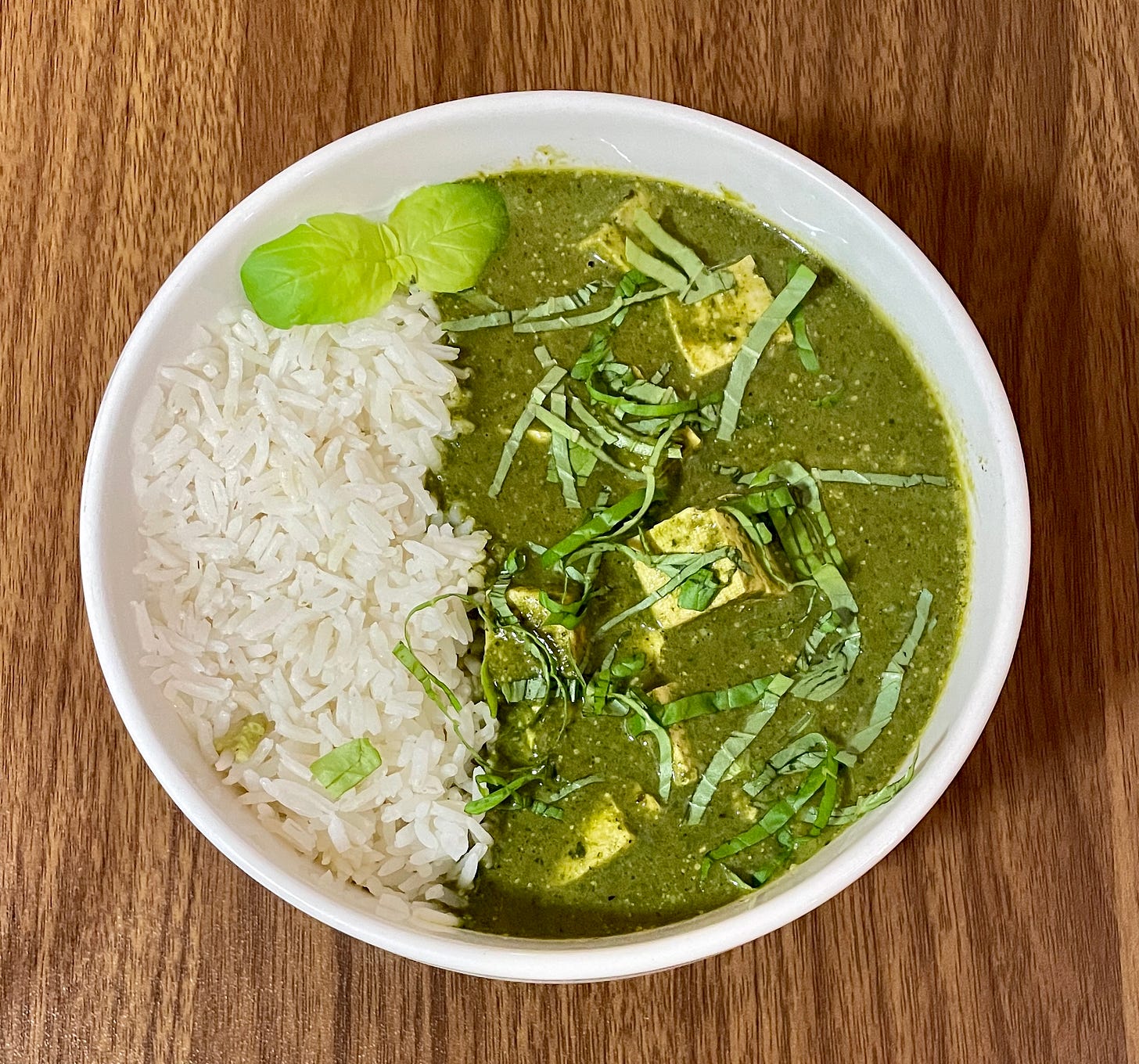BRB w/ Nathan P – Insect Farming, Saag Tofu Curry & Stories That Stick
Insects as a pillar in more circular food systems, a creamy and comforting Indian(ish) curry, and a few storytelling tips to make customers remember you (#40).
Welcome back to BRB w/ Nathan P, your 5-min weekly dose of climate information to inspire climate action.
My mission is to make it fun, easy, and delicious to make more sustainable decisions.
Each Wednesday, I share 💥1 Breakthrough, 🥘1 Recipe, and 📚1 Book on food & climate.
💥 Breakthrough: Insect Farming
Meat giants are growing in appetite for alternative proteins, which are poised to become a larger part of our diets. Most recently, they’re catching the insect farming bug.
Last week, Tyson invested in Dutch start-up Protix with plans to co-build a facility in the US. Not to worry: no cricket nuggets coming anytime soon.
Insects are a remarkably sustainable protein source. But merely mentioning the word ‘insect’ can trigger someone, let alone the ick-factor of consuming them. Whether or not we’re eating them directly, insects have their place in our food system.
This week’s post will dive into what the buzz is all about:
The case for insect protein
Why start-ups are making a key pivot
Insects towards more circular thinking
1. The case for insect protein
Insects are high in protein and require fewer resources to grow than animals. And with protein demand expected to double by 2050, entrepreneurs are turning to insects for solutions.
Insects are more efficient at converting food into biomass than larger animals. They are fully edible and have high protein content – reaching 77% in grasshoppers.
They are also much more sustainable. Per gram of protein, insects:
💨 Produce 100X fewer GHG gases than cows
👩🌾 Require 14X land than cows and 3X less than chicken
🌾 Need 2g of food to make 1g of protein vs. 7g for cows
And there are over 2,000 edible insects to choose from – how exciting, right?
Dozens of start-ups are scaling insect farming to bring new proteins to the masses, often feeding them food waste streams in vertical farms.

You may have seen cricket flour as an ingredient in bars, snacks, and baked goods. I tried a cricket protein bar a few years ago and found it unpleasantly bitter – hopefully the flavors have improved since.
While insects are popular in some cultures, they have yet to garner interest for human consumption in the West. So start-ups are changing course…
2. Why start-ups are making a key pivot
Many well-funded insect start-ups began with the promise of sustainable and affordable insect protein for all.
But as consumers remain understandably hesitant and reluctant to include insects in their diets, start-ups recently revamped their strategies towards animal feed and pet nutrition.
French unicorn Ynsect is amongst the most well-known – raising a whopping $625M to date – to exhibit this pivot.
They began by farming a variety of insects: flies, locusts, and crickets. Eventually, they settled on mealworms, the larvae stage of beetle. Mealworms are well-suited for vertical farms as they do not fly or jump and thus take less space to grow.
Ynsect currently focuses on fish feed and now dog food in the US, though they still spire to land on human plates with insect-blended patties, pasta, and baked goods.

Insect protein is exciting in the alternative proteins space because of its potential to produce not just tons of protein, but thousands of tons.
Another French unicorn InnovaFeed is developing the “world’s largest insect production site” in partnership with ADM. The facility is expected to produce 60,000 tons of protein and 20,000 tons of oils for dog food, and 400,000 tons of fertilizer.
Despite some setbacks, the insect protein market is growing quickly and expected to reach $2.8B by 2030.
The growth of insect protein also reveals a much-awaited paradigm shift in the food world: circular thinking.
3. Insects toward more circular thinking
Insects, like fungi, are amongst the micro-recyclers of the planet. They feed on animal remains and plant matter, digesting these nutrients and making them available to other organisms.
They can help upcycle lost nutrients back into our food systems. Kenyan start-up InsectiPro feeds fruit waste and beer byproducts to black soldier flies, whose larvae can be fed to farmed fish.
Protix has also shown efficient insect farming with black soldier flies, who Tyson hopes can consume their beef carcasses to make nutritious chicken feed. It helps reduce emissions from rotting and reduce monocultural grain feed.
Insects are another asset to our food systems more circular. And with regulatory processes still in the early stages, it’s only the beginning of their potential towards more sustainable food.
🥘 Recipe: Saag Tofu Curry
Saag is an Indian green curry, which inspired this vegan variation with spinach, garlic, coconut milk, and tofu.
I also swapped whole coriander with the ground version for smoother texture. Enjoy with rice, roti, and your besties. Reply to this email for the recipe.
If you make it, please send pictures :)
📚 Book: Stories That Stick
Great branding starts with great stories. Our favorite brands tell stories we resonate with – whether it’s Apple, Nike, or Warby Parker.
Storytelling is also key for climate start-ups – to attract talent, raise capital, and sell to customers. To compete with the meat & fossil fuel incumbents, start-ups need to tell inspiring stories that can enable change.
Yet the importance of storytelling in business wasn’t always evident, as Kindra Hall explains in Stories That Stick.
Marketing used to be grounded in facts and logic, not emotions. But as Kindra explains, “stories are the bridge between what we think and what we feel.”
I loved listening to the audiobook of Stories That Stick this week. Here are a few storytelling tips that resonated with me:
Involve baseline emotions: when telling a story, don’t forget to include the baseline emotion before a problem is solved. Were founders frustrated by the lack of options, or did vegan consumers feel excluded?
Reduce cognitive strain: less thinking increases purchases. Too many choices, long ingredient lists, and bullet points increase cognitive strain. A good story makes it simple – and keeps customers in Kahneman’s intuitive, System 1 thinking.
Focus on the customer: let the customer be the hero in your brand’s story, and your company be the guide. Customers should see themselves in your brand’s narrative.
Highlight specific, emotional moments: “stories are only as strong as the emotions they elicit” and “the more specific the story, the more universal the appeal.”
What are are some other brands you think tell great stories?
Thank you for reading – BRB next week ✌️
About Me
Hi there! My name is Nathan Paumier – I’m an avid reader, food enthusiast, and climate optimist. I started this newsletter after frequent questions on food tech, reading recommendations, and my secret recipes.
Want to get in touch or chat further? Anything you’d like to hear more of?
Forwarded this email?
Subscribe below to receive an email from me every week.
No spam, just quality ingredients.









Saag Tofu Curry is my favorite :)
Glad you like it too! Made it with rice this time and will aim for some homemade naan / roti next time too :)